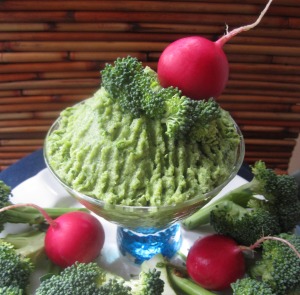 At the American Institute of Cancer Research’s 23d annual conference of scientists throughout the world who study the anti-cancer effects of foods, a few plants took top honors:
At the American Institute of Cancer Research’s 23d annual conference of scientists throughout the world who study the anti-cancer effects of foods, a few plants took top honors:
among them, broccoli, a member of the Brassica, or crucifer, family, famous for its stinky sulfurs. Broccoli and broccoli sprouts are the best sources of sulforaphane, a key cancer-fighting compound that’s produced by enzymes in crucifers.
But how you prepare broccoli is key. Raw or cooked? If cooked, how? And combined with what?
Dr. Elizabeth Jeffery, professor of food science and nutrition at the University of Illinois, dropped a few bombshells on all of us in attendance:
Broccoli is best when it’s lightly cooked, she says.
That’s because broccoli is “bi-sulfurous,” so to speak, meaning it can swing either way. (I made up that word.) When broccoli’s enzymes act on its sulfur-containing compounds, those compounds can get turned into either sulforophanes, which fight cancer, or nitriles, which don’t. “(E)very molecule of nitriles formed is a sulforaphane not formed, ” Jeffery says. Adding just a little heat will keep nitriles from forming.
But doesn’t heat destroy the enzymes, too? Too much heat does, Jeffery says. Thus steam broccoli for 3 to 4 minutes (using a steamer basket so the food doesn’t touch the cooking water) or blanch it for 20 to 30 seconds–until bright green and crispy.
Then Jeffery dropped another bombshell, based on her latest research in humans: You can add back those enzymes by eating cooked broccoli along with a little raw crucifers–a teaspoon or less of spicy mustard or wasabi or a handful of watercress or arugula or a couple of raw red radishes.
Most other crucifers work the same as broccoli: Cook them lightly to keep nitriles from forming, then follow the rule I’m dubbing “The Red Radish Rule for Consuming Crucifers.” (I made up that name, too.)
But as with everything, there are exceptions. For the few crucifers that don’t produce nitriles, feel free to embrace them raw and forget about combining. One crucifer, however, actually MUST be eaten raw because it produces nitriles only when cooked. Want to know more? Read all about these exceptions here—
and let me know if you’d like to test out an anti-cancer recipe for broccoli dip with raw red radishes.

Yes! Love it!
LikeLike
It’s coming soon, Mary, in my soon-to-be released e- book, “Eat and Beat Cancer: Create your Own Anti-Cancer Kitchen.” If you want to try the recipe before the book comes out, let me know. I need some testers.
LikeLike
Merci pour tout
Je veux bien l’essayer ,comme d ailleurs toutes les recettes précédentes ;delicieuses
Affectueusement
Fettou
LikeLike
i have just read that adding a radish, or other raw brassica/arugula maybe, or as suggested here, wasabi or mustard to cooked brassicas will help the enzyme turned to turn back to the better variety. how can that be i wonder? but the researchers said it is so;-)
LikeLike
Looks like I’m batting 1,000 today. I had lightly steamed broccoli in my morning omelette….with a sprinkle of dill, and a few crumbles of goat cheese. Yum! Thanks for supporting my cruciferous veggie habit with such good news.
LikeLike
Pingback: Microgreens, Newborn Perfection | Weeds of Wisdom ®
I read you should use mustard powder or mash broccoli before heating it? Is that correct
LikeLike
Mustard powder gives you the myrosinase enzymes that activate cancer-fighting sulfur compounds and that are destroyed by heat. Adding it to cooked broccoli will compensate for the myrosinase enzymes lost by heating broccoli.
Mashing broccoli is not necessary. Cutting the broccoli will break the cell walls, thus releasing myrosinase.
Mind sending along the source of that statement? Thanks for asking.
LikeLike
Pingback: Anti-Cancer Recipes: Should you Cook Onions? | Eat and Beat Cancer
Pingback: #AICR19 Takeaway: Change Your Metabolism | Eat and Beat Cancer